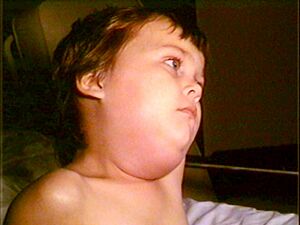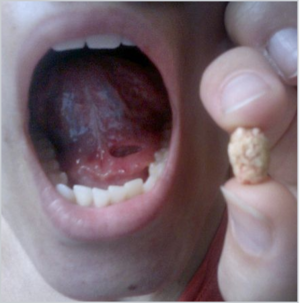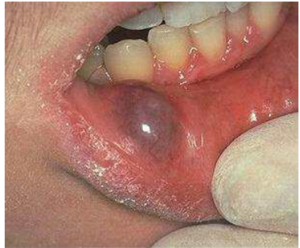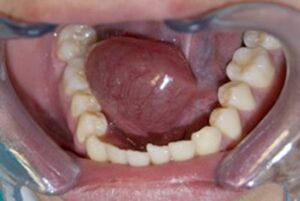2. Pathology of the salivary glands
Written by ms. worldwide, edited by Nikolas.
Another topic where there’s a lot of listing of different diseases, yay…
Salivary glands can be enlarged for multiple reasons:
- Sialadenitis – inflammation
- Sialolithiasis – stones in the salivary glands
- Tumorlike lesions
- Salivary gland tumors
Let’s take a closer look at all of them
Sialadenitis – inflammation of the salivary glands
Inflammations of the salivary glands come in many different types.
Bacterial sialadenitis
Bacterial sialadenitis is an acute purulent inflammation, which is mostly found in the elderly patients. Risk factors for this are:
- Dehydration
- Sialolithiasis (stones)
- Malnutrition
- Immunosuppression
The bacteria which are the cause for these inflammations are Staphylococcus aureus, streptococcus viridians and intestinal bacteria.
Viral sialadenitis
Unlike the bacterial type, Viral sialadenitis is much more common and seen in children. Mumps is the most famous reason and causes hamster cheek because of the swelling of the parotid glands.

Typical viruses causing this are:
- Paramyxoviridae (mumps)
- Epstein-Barr virus
- Coxsackie A
- Cytomegalovirus
- Influenza
Complications from this can be deafness and if the mumps is the cause, recall from micro that the testis may also become inflamed.
Autoimmune sialadenitis – Sjögren syndrome

Sjögren syndrome is associated with anti-SSA and SSB antibodies and is typically found in middle-aged women. The syndrome makes the both parotid glands swell, and it’s pretty painful too. In addition to attack the salivary and lacrimal glands, it also manifests by dry mouth dry eyes and rheumatoid arthritis.
We call it secondary Sjögren syndrome when the typical symptoms can be seen in other autoimmune diseases, like e.g. scleroderma, myasthenia gravis and SLE.
To make a diagnosis, a biopsy from the lip can be taken.
Mikulicz syndrome
This rare autoimmune disease leads to bilateral swelling of the salivary and lacrimal glands which is painless. The etiology is unknown.
It is considered benign, but can accompany more severe and aggressive conditions like
- Sjögren syndrome
- Lymphoma
- Tuberculosis
- Syphilis
- HIV-infection
Heerfordt syndrome
Heerfordt syndrome is a rare manifestation of sarcoidosis in the salivary glands.
It leads to granulomatous parotitis (swelling), inflammation of the eyes and fever. In some cases, there may also be palsy of the facial nerves.
More about sarcoidosis can be studied in the pathology 1 section.
Sialolithiasis – stones in the salivary glands

Sialolithiasis
The stones of the salivary glands occur mostly in the main duct of the submandibular glands, and the etiology of them is unknown.
The patients with this experience pain and swelling when they are thinking of food, smelling delicious food or during meals and hunger. The stones can also lead to ulceration of the mucosa and fistulation.
The stone itself is bright yellow with granular surface.
Chronic sclerosing sialadenitis
This condition is rare and occurs due to long-term inflammations of the salivary glands. It’s considered benign, but presents as hard, indurated and big masses that are clinically impossible to distinguish from salivary neoplasms and tumors.
When in the submandibular gland, it is called the Küttner’s tumor.
Tumorlike lesions

Mucocele
Mucoceles are small, painless cysts of a salivary gland which exists in two forms: The retention/obstructive type and the extravasation/pseudocystic type.
The retention mucocele has squamous epithelial lining and is caused due to obstruction and is most common in 60-80-year-old patients. Its location is often the inner side of the lower lip.
The extravasation type mucocele is however most frequent in children and young adults, but it is also often located in the lower lip.

Ranula
This is basically an extravasation type mucocele of the sublingual gland which is found in the base of the mouth. It looks like the sack of a frog.
Salivary gland tumors
Most of the salivary gland tumors are from epithelial origin, and they dominate in women. They are also mostly benign, but as with everything, they can be malignant as well. The usual location is parotid gland (80 %), followed by submandibular gland.
Pleomorphic adenoma
Pleomorphic adenoma is the most frequent benign tumor, and usually appears in the parotid gland at any age.
It is a slow-growing painless neoplasm with unknown etiology. Since it usually grows in the parotid gland and can get pretty big, so it can compress the facial nerve and cause palsy. The close location to the facial nerve makes also removal of the tumor very hard, and if it’s not removed completely, there is a high risk for it to reoccur. However, only 6 % of all cases turn into a malignant type.
Whartin-tumor (adenolymphoma)
The Warthin tumor is also known as papillary cystadenoma lymphoatosum and is a benign cystic tumor of the salivary glands which contains lymphocytes and germinal centres, hence the name adenolymphoma. It much less frequent than the pleomorphic adenoma, but they both occur almost always in the parotid gland.
This tumor dominates in men and has a strong connection to smoking.
Mucoepidermoid carcinoma
This carcinoma is the most frequent malignant tumor in the salivary glands, and in appears in the parotid gland in 2/3 cases.
It appears as a mixed tumor, and in histology we can see squamous cells, mucus-secreting cells and undifferentiated cells. The tumor originates also from the duct of the gland.
The risk factor is radiation, and the prognosis depends of the differentiation grade. If the tumor is poorly differentiated, the prognosis for survival is very low. Morphology they appear to be circumscribed but the tumor lacks well-defined capsules and are often infiltrative.
Adenoid cystic carcinoma
This is a rare cancer, and can occur in the breasts, lacrimal glands, lung and brain as well, but most commonly in the salivary glands.
It can be found in all salivary glands and appears in middle-aged patients. The prognosis is however poor.
